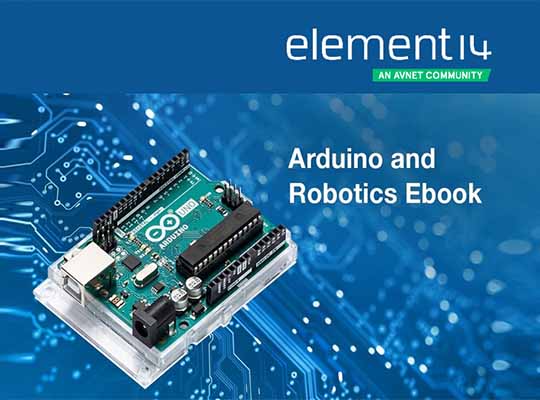Bangalore, India – element14 has released a new eBook that provides an overview of how to get started in robotics using the Arduino platform. This eBook covers the basics from development to implementation, discussing the hardware and interfaces, programming an Arduino, examples of robotics projects, and much more.
Arduino is an open-source hardware, software and content platform that has powered thousands of users, be it beginners or seasoned engineers over the years, enabling them to create projects ranging from everyday objects to complex scientific instruments. Unlike most previous programmable circuit boards in decades past, Arduino does not need a separate piece of hardware to program and upload code to the board; instead users simply use a pre-programmed SD card, or they connect the board to a computer.
In this eBook, you will learn why the Arduino is a great choice for a robotics platform. Arduino has a wide range of options for robotics applications, with a variety of base Arduino boards available and many expansion options to add features and functionality. Arduino can be used to create handheld gaming consoles, soil monitors, home automation systems, and more. The new eBook explores how all that has been made possible.
Some of the best projects to help further your growth in the exciting, and now accessible, field of smart robotics, include:
- Midhun_’s Self Balancing Robot: This Self Balancing Robot is a great entry-level build, and can remain upright even while moving and avoiding obstacles in its path. The tiny 4-inch-tall robot was designed around the Arduino Pro Mini and uses an MPU6050 accelerometer-gyroscope module to maintain balance
- Technovation’s Arduino Controlled Robotic Biped: A compact robot driven by the Arduino Uno. The build is a great example of how a bipedal robot is designed and constructed using readily available hardware, besides its 3D printed legs. The Arduino Uno is responsible for computing the motion paths of the robot’s various gaits, and it instructs the actuators to move to precise angles and speeds to create a smooth walking motion
- Petoi’s OpenCat: The OpenCat robotic cat is one of the more complex builds to take advantage of the Arduino. In its current form, the OpenCat uses a Raspberry Pi 3 Model B to control the robot’s higher functions and sensing capabilities, including sonic sensors and LiDAR for navigation. The Pi is paired with an Arduino Pro Mini tasked to control the cat’s motion, which is driven by 13 MG92B servos and a single MG91 servo. While it lacks the agility of living felines, the OpenCat is programmed with multiple gates, object detection/avoidance, motion tracking, and facial recognition. It can even purr when it’s petted
For more information on Arduino and Robotics, please check out our resources here, and to read the full eBook, please visit element14.com













